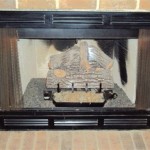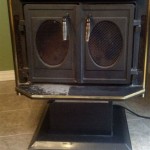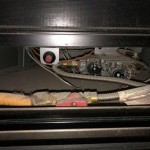Replacement Glass for Fireplace: A Comprehensive Guide
The fireplace stands as a central feature in many homes, providing warmth, ambiance, and a focal point for gatherings. The glass panel, specifically, plays a crucial role in functionality and safety. It allows for unobstructed viewing of the fire while containing sparks, embers, and heat within the firebox. Over time, fireplace glass can become damaged due to thermal stress, impact, or improper cleaning. Replacement glass is a necessity in such instances to maintain the fireplace's performance and safety.
This article provides a comprehensive overview of replacement fireplace glass, covering the different types available, factors to consider when selecting replacement glass, the installation process, maintenance tips, and safety precautions.
Understanding Types of Fireplace Glass
Not all glass is created equal, particularly when it comes to withstanding the high temperatures generated by a fireplace. Using standard window glass or other inappropriate materials poses a significant safety risk. Specialized glass types are engineered to handle the extreme thermal conditions within a fireplace enclosure. Understanding these types is the first step in choosing the correct replacement.
Ceramic Glass: This is the most common type of fireplace glass used in modern fireplaces and wood stoves. Ceramic glass, such as Neoceram or Robax, is specifically designed to withstand continuous high temperatures, often up to 1300°F (700°C). It exhibits low thermal expansion, meaning it doesn't significantly expand or contract when heated, reducing the risk of cracking or shattering. Ceramic glass offers excellent clarity and durability, making it a reliable and safe option for fireplaces.
Tempered Glass: While less common in high-heat fireplaces, tempered glass can be found in some gas fireplaces or fireplace screens that are positioned further away from direct flames. Tempered glass undergoes a heat treatment process that makes it significantly stronger than standard glass. However, it has a lower heat resistance compared to ceramic glass and is more prone to shattering if exposed to extremely high or rapidly changing temperatures. Tempered glass is generally not suitable for wood-burning fireplaces.
Borosilicate Glass: Borosilicate glass is known for its excellent thermal shock resistance and is sometimes used in fireplace applications where rapid temperature changes are expected. It is less common than ceramic glass but can be a suitable option in specialized situations where the fireplace experiences fluctuating temperatures.
The specific type of glass required depends on the manufacturer's specifications for the fireplace model. Consulting the fireplace's owner's manual or contacting the manufacturer is crucial to ensure the correct glass type is selected. Using an incorrect glass type can lead to breakage, potential injury, and damage to the fireplace unit.
Factors to Consider When Selecting Replacement Glass
Beyond the type of glass, several factors influence the selection of replacement fireplace glass. These considerations ensure a proper fit, optimal performance, and adherence to safety standards.
Accurate Measurements: Precise measurements are paramount for a secure and airtight seal. The glass must fit snugly within the fireplace frame to prevent air leaks, which can affect the fireplace's efficiency and safety. Measure the existing glass panel carefully, or if the original glass is unavailable, measure the inside dimensions of the fireplace frame where the glass will be installed. Measurements should be taken in inches or millimeters, depending on the supplier's requirements. Double-checking the measurements is highly recommended to avoid errors.
Thickness of the Glass: The thickness of the glass contributes to its strength and thermal resistance. Fireplace glass typically ranges from 3/16 inch to 1/4 inch in thickness. The manufacturer's recommendations should be followed regarding the appropriate thickness for the specific fireplace model. Using a thinner glass than recommended may compromise its structural integrity, while using a thicker glass may create installation issues.
Shape and Style: Fireplace glass comes in various shapes and styles, including rectangular, arched, and custom designs. The replacement glass should match the original shape and style to maintain the aesthetic appeal of the fireplace. Some fireplaces may require specific glass shapes to accommodate the door or frame design. When ordering replacement glass, provide clear information about the shape and any unique features.
Manufacturer Specifications: Refer to the fireplace manufacturer's specifications for the recommended glass type, thickness, and dimensions. The manufacturer's guidelines ensure compatibility and safety. If the owner's manual is unavailable, contacting the manufacturer directly or consulting with a qualified fireplace technician is advisable.
Glass Tint and Coating: Some fireplace glass may have a tint or coating to reduce glare, enhance the flame view, or improve energy efficiency. Consider the desired aesthetic and functional benefits when selecting replacement glass. Anti-reflective coatings can minimize glare, while tinted glass can add a touch of elegance to the fireplace.
Certification and Safety Standards: Ensure that the replacement glass meets relevant safety standards and certifications. Look for glass that is tested and certified to withstand high temperatures and thermal shock. Compliance with industry standards provides assurance of the glass's quality and safety performance.
The Replacement Process: Step-by-Step Guide
Replacing fireplace glass typically involves a straightforward process, but it requires careful attention to detail and adherence to safety precautions. If unsure about any step, consult with a qualified fireplace technician.
Safety First: Before starting the replacement process, ensure the fireplace is completely cool. Turn off the gas supply if it's a gas fireplace. Wear gloves and safety glasses to protect your hands and eyes from sharp edges and debris. Lay down a drop cloth or protective covering around the fireplace to catch any falling debris or broken glass.
Removing the Old Glass: Carefully remove any screws, clips, or retainers that secure the glass panel in place. These fasteners may be located around the perimeter of the glass or on the door frame. Gently pry the old glass loose from the frame. If the glass is broken, use caution when handling the pieces to avoid injury. Dispose of the broken glass properly according to local regulations.
Cleaning the Frame: Once the old glass is removed, thoroughly clean the fireplace frame or door. Remove any old sealant, adhesive, or debris that may prevent the new glass from seating properly. Use a scraper or putty knife to remove stubborn residue. Clean the frame with a mild detergent and water, then dry it completely.
Applying New Sealant: Apply a bead of high-temperature sealant around the perimeter of the frame where the new glass will sit. The sealant helps create an airtight seal and prevents air leaks. Use a sealant specifically designed for high-temperature applications, such as silicone-based sealant or fireplace cement.
Installing the New Glass: Carefully position the new glass panel into the frame, making sure it is centered and aligned properly. Press the glass firmly into the sealant, ensuring a tight and even seal. If necessary, use shims or spacers to hold the glass in place while the sealant dries.
Securing the Glass: Replace the screws, clips, or retainers that were removed earlier. Tighten the fasteners securely, but avoid over-tightening, which could crack the glass. Double-check that the glass is securely held in place and that there are no gaps or air leaks.
Curing the Sealant: Allow the sealant to cure completely according to the manufacturer's instructions. This may take several hours or even overnight. Avoid using the fireplace until the sealant is fully cured.
Maintenance and Care of Fireplace Glass
Proper maintenance extends the life of the fireplace glass and preserves its clarity. Regular cleaning and preventive measures contribute to the fireplace's overall performance and safety.
Regular Cleaning: Clean the fireplace glass regularly to remove soot, creosote, and other deposits that can accumulate on the surface. Use a specialized fireplace glass cleaner or a mixture of vinegar and water. Avoid using abrasive cleaners, as they can scratch or damage the glass. Apply the cleaner to a soft cloth and gently wipe the glass surface. Rinse with clean water and dry thoroughly. Cleaning frequency depends on the usage of the fireplace; however, cleaning after several uses is recommended.
Avoid Abrasive Cleaners: Abrasive cleaners, such as scouring pads, steel wool, and harsh chemicals, can scratch and damage the surface of the fireplace glass. Always use gentle, non-abrasive cleaning methods to avoid damaging the glass.
Proper Ventilation: Ensure proper ventilation in the room when using the fireplace. Adequate ventilation helps prevent the buildup of soot and creosote on the glass. Open a window or use a ventilation fan to improve air circulation.
Burn Proper Fuel: Burning the correct type of fuel is crucial for maintaining fireplace glass. Use seasoned firewood or approved gas fuel as recommended by the fireplace manufacturer. Avoid burning trash, paper, or other materials that can produce excessive soot and creosote.
Inspect Regularly: Regularly inspect the fireplace glass for cracks, chips, or other damage. Minor damage can quickly worsen with repeated heating and cooling cycles. If any damage is detected, replace the glass immediately.
Safety Precautions
Safety considerations are paramount when dealing with fireplaces and fireplace glass. Adhering to these precautions minimizes the risk of accidents and ensures safe operation.
Never Use the Fireplace with Damaged Glass: Using a fireplace with cracked or broken glass is extremely dangerous. Damaged glass can shatter under high temperatures, posing a risk of injury and fire. Replace damaged glass immediately.
Keep Flammable Materials Away: Keep flammable materials, such as curtains, furniture, and paper, away from the fireplace. Maintain a safe distance to prevent accidental fires.
Install a Carbon Monoxide Detector: Install a carbon monoxide detector in the room where the fireplace is located. Carbon monoxide is a colorless, odorless gas that can be produced by incomplete combustion. A carbon monoxide detector provides an early warning of dangerous levels of the gas.
Supervise Children and Pets: Supervise children and pets around the fireplace. The glass surface can become very hot and cause burns. Keep a safe distance and teach children about the dangers of fire.
Annual Inspections: Schedule annual inspections of the fireplace by a qualified professional. A professional inspection can identify potential problems and ensure the fireplace is operating safely and efficiently.
Replacing fireplace glass is a necessary maintenance task to ensure the safe and efficient operation of the fireplace. Understanding the different types of glass available, considering the factors that influence glass selection, and following proper installation and maintenance procedures are all essential for a successful replacement. When in doubt, consult with a qualified fireplace technician to ensure the job is done correctly and safely.

Fireplace And Wood Burning Stove Glass Replacement

Standard Size Masonry Fireplace Doors Fixed Frame

Fireplace Glass Replacement Lancaster Paint

Everything You Need To Know About Fireplace Glass Door Replacement Demers

Fireplace Replacement Glass For Prefab Doors Parts

Fireplace Glass Replacement Me And My

Fireplace Glass Replacement Wood Stove Gas
Fireplace Glass Installation Repair Demers

Tempered Fireplace Door Glass In Clear Finish

Fireplace Replacement Glass Marion And Mirror
Related Posts








